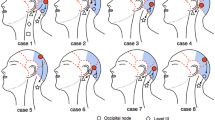Abstract
Background
The purpose of this study was to evaluate the superficial lymph drainage patterns from primary lesions, with the primary focus on cheek/eyelid and lip melanomas.
Method
We conducted a retrospective study of 22 patients with facial melanomas who had undergone neck dissection or sentinel lymph node biopsy at the hospital from 1981 to April 2011. We then analyzed the dominant lymph drainage patterns from the cheek/eyelid and lip regions.
Results
The cheek/eyelid regions have two lymph drainage patterns: one is to the parotid nodes and the other is to level IB. The lymph drainage patterns in the lip region are to level IA or IB. The lymph drainage patterns to superficial lymph nodes from the primary sites were determined in both regions.
Conclusions
Cheek/eyelid and lip melanomas have lymph drainage patterns different from those of malignant tumors of the oropharyngeal and larynx regions. Superficial lymph node groups also play an important role in facial melanomas.






Similar content being viewed by others
References
Hayashi T, Furukawa H, Oyama A et al (2011) Sentinel lymph node biopsy using real-time fluorescence navigation with indocyanine green in cutaneous head and neck/lip mucosa melanomas. Head Neck (Epub ahead of print)
Gonzales-Ulloa M (1956) Restoration of the face covering by means of selected skin in regional aesthetic units. Br J Plast Surg 9:212–221
O’Brien CJ, Uren RF, Thompson JF et al (1995) Prediction of potential metastatic sites in cutaneous head and neck melanoma using lymphoscintigraphy. Am J Surg 170:461–466
Wells KE, Cruse CW, Daniels S et al (1994) The use of lymphoscintigraphy in melanoma of the head and neck. Plast Reconstr Surg 93:757–761
Leong SP, Achtem TA, Habib FA et al (1999) Discordancy between clinical predictions vs lymphoscintigraphic and intraoperative mapping of sentinel lymph node drainage of primary melanoma. Arch Dermatol 135:1472–1476
de Wilt JH, Thompson JF, Uren RF et al (2004) Correlation between preoperative lymphoscintigraphy and metastatic nodal disease sites in 362 patients with cutaneous melanomas of the head and neck. Ann Surg 239:544–552
Pathak I, O’Brien CJ, Petersen-Schaeffer K et al (2001) Do nodal metastases from cutaneous melanoma of the head and neck follow a clinically predictable pattern? Head Neck 23:785–790
Lin D, Franc BL, Kashani-Sabet M et al (2006) Lymphatic drainage patterns of head and neck cutaneous melanoma observed on lymphoscintigraphy and sentinel lymph node biopsy. Head Neck 28:249–255
Conflict of interest
No author has any conflict of interest.
Author information
Authors and Affiliations
Corresponding author
About this article
Cite this article
Hayashi, T., Furukawa, H., Oyama, A. et al. Dominant lymph drainage in the facial region: evaluation of lymph nodes of facial melanoma patients. Int J Clin Oncol 17, 330–335 (2012). https://doi.org/10.1007/s10147-011-0293-4
Received:
Accepted:
Published:
Issue Date:
DOI: https://doi.org/10.1007/s10147-011-0293-4




